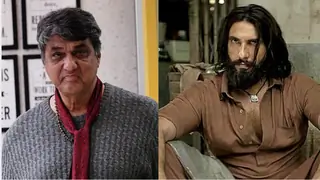Folks,
Having just surfaced, past midnight, from an internet breakdown since this Sunday afternoon, let me get this off before anything does wrong again!
Before starting with these weekly posts, I usually watch the 4 episodes once more, back to back, as a kind of refresher course. This time, I started with a hazy impression that it was mostly action on the story front and very little of the kind of splendid confrontations that abounded during the week before, or even much of emotion.
At the end of the re-viewing, I had to revise this impression. Yes, there was not much of confrontation, unless you count Rudra's herogiri with the Veshes or theirs with Maya, or the farcical one of Charles with his bete noire, DM Tiwari (clearly orchestrated to reveal that the DM was also a garud, with his sign on the left shoulder, perhaps to underline his being always at chattees ka aankhda with Charles, who has his on the right shoulder😉!), and Prof. Rao. However, there was a succession of highly emotional scenes thru the week, all superbly scripted, directed and enacted.
But of those later, as I get to my Take 5. For now, let us concentrate on the title, for that is what is cooking currently in our tale, or rather bubbling and boiling like a witches' cauldron as Mahakumbh moves into fifth gear.
Of nagas and garudas: Well, first of all, my heartfelt thanks to Utkarsh for not letting us in for some remixed version of JK Rowling's Dementors! He has stayed true to the very traditional ethos of Mahakumbh, and gone back to our mythology to set up this mahayudh, as predicted by Naanu's white- maned Guru Maharaj.
The garuda-naga conflict is a staple of our mythology*, where it resembles another age-old rivalry and endemic hostility , that between the Devas and the Asuras. Both are rooted in a feeling, on the part of the nagas and the Asuras, of having been cheated and consistently discriminated against and persecuted by the other side, sometimes with justification. As after the samudramanthan for the Asuras, and for the nagas, after Garuda took them for a ride (see footnote below) and conned them out of the selfsame amrit.
This garudas vs nagas theme recurs in the Mahabharata, when the Pandavas go to Khandavaprasta. Only there the naga king Takshak features prominently, and there are no 7 elite nagas, which are an Utkarsh special!
Unlike our garudas, these sapta nagas, who seem to be students of Thai kickboxing, do not look at all different one from the other. They all have the naga sign in the same place, on the right shoulder, and of the same size. They are all shown to be in lock step with each other, making exactly the same moves, whether it is walking on their hands or in their fighting. Still, I am sure there will be a primus inter pares among these 7, like Rudra among the garudas.
Nagas: black or grey?: Now the 'Veshes are pure evil, and so too must their Guru Maharaj be. But it does not follow that the nagas, whose powers these three hope to use for their own ends, are evil as well. They are the adversaries of the garudas, yes, but they are not, so far as I know of the puranas, in any way evil. It is rather that, in literal terms, their lifestyles and their interests clash with those of their more sophisticated adversaries. Shruthi has remarked elsewhere that the garuda vs naga struggle is almost like a class or caste conflict, but I would rather see it as that of a tribal population vs the city slickers.
To revert, here, in the context of the amrit, the nagas are likely to be cast as proto-Asuras, and our heroes, the garudas, as the representatives of the Devas. It will be interesting to see if Utkarsh avoids the temptation to paint the nagas black. In our mythology, while the Nagaraj Takshak was wicked, deceitful and vengeful, Adisesha, and his younger brother Vasuki, are samarpit to Lord Vishnu and Lord Shiva respectively, so it is much more nuanced.
The two sides here are bound to be fairly evenly matched, nahin to mahayudh kahan se hoga? It is not just possible, but very likely that there would be a powerful naga to match every garud (but one!), for as I had noted in Part 1 of my last week's post, Mahakumbh is clearly not going to a mythic tale, like Tolkien's classic The Lord of the Rings, of small people, like Frodo the Hobbit and his supporters, triumphing over even the greatest evil thanks to sheer guts, doggedness and pureness of heart. It is going to be more of a clash of the titans, of good and of evil.
Rudra: primus inter pares: However, it does not follow that any of the nagas can be more powerful than the shreshtatam garud, Rudra, or even equal to him. To take a mythological example, Adisesha, the foremost among the nagas, is very powerful, but he is subordinate to Mahavishnu, which is why he is Lakshmana in the Ramayana, and Balarama in the Mahabharata, an anshaavatar, not a purnaavatar like Rama or Krishna.
As for Rudra, by the end, I suspect the parallel with Lord Shiva will be far more marked, for those resonances will have to be captured by the script, seeing that it all revolves around amrit and not some conventional hidden treasure.
So I feel that Rudra will stand alone as primus inter pares among all the 14, even if at times he is weakened by his emotional side. Guru Maharaj's cryptic prophecy that the nagas would prevail over the garuds when the latter bhavanaon ki jaal mein padkar kamzor honge. would seem to apply to Rudra above all, due to his involvement with Maya. This was already hinted at in the promo.
So now, on top of the existing confusion about the rest of the garudas, we have the additional puzzle about the identity of the 7 nagas, who are sure to arrive at the Mahakumbh in assorted human forms, as shown .And if they look like septets, Heaven help us!😉___________________________________________________________________________
*NB: This is a fascinating story about the origins of the garuda-naga enmity that Mishti had posted on my last thread. I am sure she will not mind my sharing it with you all. Here it is.
"Kasyapa rishi was the father of Garuda, and Vinata was his mother. The other wife of Kasyapa rishi was Kadru, mother of the serpents or naags (including Adisesha).
There was a wager between the two wives over the color of the Indra's horse, which Vinata lost and, as per the terms of the wager, she became a slave of Kadru. Garuda requested his step mother to release Vinata, and Kadru asked for the amrit from the Devas in return. Garuda defeated the Devas and got the amrit. He also impressed Lord Vishnu so much that he made Garuda his vaahan.
For his part, Indra made a deal with Garuda so that the amrit would be returned to the Devas. So Garuda took the amrit to the nagas and first got them to free his mother Vinata .
Then , he asked the nagas to first purify themselves thru ablutions, and covered the amrit kumbh with durva grass.When the nagas were gone, he let Indra take away the amrit. When they returned, they licked the grass, thinking that the amrit kumbh was beneath it. Their tongues were cut by the sharp durva, whence the forked or bifid tongues of all snakes.
Garuda and the nagas thus became arch rivals. Garuda feeds on snakes but the latter also found a way to counter Garuda by swallowing stones and making themselves heavy. But their war continues."
Incidentally, Rishi Kasyapa was also the husband of Aditi, a daughter of Prajapati Daksh, who was, as you would know, the father of Sati, Shiva's first wife. The 51 sites of the eventual Shaktipeeths, including Prayag and the Manikarnika Ghat where our Rudra was raised, are the places where parts of her burnt body, that Shiva, devastated by her atmadahan, was carrying across the world in his arms, fell to the earth. The Manikarnika Ghat is said to be the place where her earrings landed.
Aditi was the mother of all the Devas. His other wife Diti was the mother of all the Asuras. These Rishis seem to have really got around, with so many high powered wives, each of whom bore not children but a whole tribe! __________________________________________________________________________
Of renunions and separations: There is only one separation, that of Maya from Rudra (unless you count that of the brutish Animesh from his life, which Rudra sees as in the past tense: Agar zinda hota to zaroor mar deta!) That too, as ThappadiyaMai predicts, is bound to be of short duration, as she has already resurfaced in the precap, undoubtedly as the maiden in distress to be rescued by apna Rudra, who makes nothing of catching a knife by the open blade!
This apart, Maya shed enough tears last week to refloat an aircraft carrier. But I must say that she carried off all this weeping (happily wordless!) with total conviction, just as she does her asthma attacks. Further, her letter to Rudra was a model of helpless guilt and grief and despair distilled into achingly convincing words: khud ko dhoondhne ja rahi hoon..apna kasam dene laayak nahin hoon, isliye Maimuyi ki kasam... and then the best line right at the very end : Pyaar sachcha tha, par Maya, Maya jhooti thi!
It was also telling that she had left her inhaler behind, perhaps to learn to breathe without that crutch once she was free of the stifling miasma in the Vesh residence!
The chief rationale for Maya's temporary exit from Rudra's life seems to be to produce a fit of anti-garuda chinna anger and frustration in Rudra, leading, by way of yet another attempt by him to get rid of the manhoos nishaan, to his reunion with his Baba.
Results from the reunions: As for the reunions, they abounded last week: Rudra's with his father, Shivanand's with Sahadev, and of course that of Shivanand with his mother. The first and last were really high voltage. And the end result of the lot was to
-acquaint the Garuda No.1, Rudra, with his life's mission, his niyati evam prarabdha, and with the whole garuda set up and its goal of safeguarding the amrit, which would emerge on the last day of this Mahakumbh, from the evil forces, in order to save humanity and human values. And, as a means to this end,
-pave the way for the re-establishment of the Brahma Nisht Panth, with Daadi's stated aim of restarting their traditional seva for the kalpavasis, as shown in the precap.
At the purely personal level, it is of course also a coming together of almost all the survivors of the family that was torn asunder in 1989. Rudra's mother will be a later entry, one presumes. So Rudra now has a new sense of belonging to a loving and caring unit, exactly what he had craved for all his life. Something that had been granted him, withMaimuyi and Udiya Baba, only to be brutally snatched away each time.
Apart from the tears and the joy, what struck me about the first and the last reunions was the light they threw on the equations and conflicts between the characters, above all between Daadi and her son Shivanand. Fascinating is the word, and very hatke as well, but more of that in the Take 5.
My Take 5 for the last week: I have done this in chronological order, not in terms of ranking. It seemed better so.
1)The Garuda detector: The whole sequence in Shivanand's underground suite, which looks like a cross between a wizard's den and the studio of an FM radio station, was fascinating, both visually and contentwise.
That is to say, it was so once one had suspended any disbelief about a computer system, layered under 24 years of dust (Shivanand clearly does not suffer from dust allergies, for he must have breathed in a good chunk of the dust he blows away from everything there!😉) that nonetheless starts up without a whimper and performs like a dream. When I remembered how my laptop was paralysed for over a day last week because of a dodgy patch that Microsoft unloaded on us, I was lost in admiration at Shiva's hardware, and software as well!
I loved the solemnity and piety with which Shiva purified himself for the ritual of (re)starting his cosmic contraption, pouring water over himself - as the wonderful Karpoora Gauram is recited in the background - and puttingon the yagnopaveetham, the sacred thread. He has a nice, round head (he has clearly done a Yul Brynner ) and shapely, symmetrical ears, so he can carry off the bald-pated act without looking comical. 😉
Then there is his whole persona. In the scenes where he gets ready to commingle with the music of the spheres, he was mesmerising. It is a very strongly defined face, with sharp planes and large but deep set eyes. He is mostly still, but with the stillness of strength, like the potential energy in a coiled spring.
He looks like a rishi, a senior one, stern, solemn and determined. But one who believes in testing traditions on the touchstone of science, not to discredit them but to strengthen his belief in them, for he is convinced that Har parampara ka koyi na koyi aadhaar hota hai. This is the root of the differences between him and his parents, but it is not that he lacks faith. Look at him as he folds his hands in prayer as the constellation of 7 rises and merges with the firmament above.
One can see the quiet pride in his face and eyes as he moves about, unhurriedly and confidently, setting up the celestial display. As he looks up at the starry skies he has created overhead, there is a pleased, satisfied smile on his face, and why not?
As for the Mystery of the Missing Garuda, that is still (literally and metaphorically!) up in the air, plus the supplementary puzzle of the two garudas in Daraganj. But Shiva's confidence and optimism are unimpaired. As he notes earlier, Shraddha aur vishwas ke saath dhairya ho, to kuchch bhi ho sakta hai.
The other thing worth noting is that Shivanand does not use the Second Book for anything except to copy a diagram of the seven locations of the garudas from it. His whole jing bang set, up, including the tonal key that unlocks the blue crystal, the 7 magical rudrakshas, and everything else, including the garuda location indicator, seems to have been set up long ago, at least 24 years ago if not more. Clearly Shivanand is a not just a scholar of ancient texts, but also a computer whiz and a sound engineer way ahead of his time, seeing that he could both assemble this hardware and write the software (which would hardly have been available off the shelf!), plus setting up the acoustic part!
Question (perhaps best left unasked!) : H ow did Shivanand set up all this stuff - not just the books, but all the electronic gizmos and what looks like a full scale radio jockey's studio - in that underground area that is part of khoye paaye Pandey's house?? The theory that no one would look for it in enemy territory is all fine, but how did HE get there undetected, and how did he bring all this material across and install it ? That too all by himself, as per Sahadev Malla? This is creative licence with a vengeance! Plus, I wondered how safe it was, with the opening of the baudi accessible to all.
2) The two Shraadhs: Rudra's Daadi, folks, is downright addictive. I find myself constantly looking out for that old, lined, weary face, but a face that is still strong, very strong, with the strength that unshakeable faith in a tradition gives one. I love her bright eyes, not in the least faded with age, but dark like little jamuns and alive with emotions that she does not feel the need to verbalise. A wonderful performer, Surekha Sikri!
As she lies in bed, asking Sahadev when the Mouni Amavaasya fell, her face crumples suddenly and tears flow out from behind closed eyelids in silent grief. Even when Rudra arrives, and strokes her hand with infinite gentleness, she is so depressed that she wishes she could just get away from it all, the ever present danger and everything else that plagues them. It was fascinating, the reversal of roles when Rudra quotes Maimuyi to his Daadi and helps her recover her composure.
Pointless self-denial: When she tells him about how his Daadiji met his end in the attack by the Veshes, she makes a curious remark: Yahan tak ki Saraswati Kund ka jal unhein laakar diya. But why does she describe this as an out of the way attempt to save his life? They were routinely serving and healing the sick with that sacred water. Then why not for Daadaji? It sounds like excessive and pointless self-denial of something that is routine for the aam janata, the kalpavaasis.
Again, I am afraid I can see no sense, nor anything to admire, in Daadaji having refused the holy water and thus opted to die, leaving his wife to fend for herself. Why? I would have admired him if he had drunk the water, recovered, and tried to rebuild their lives somehow, there or elsewhere.
The whole shraadh sequence was beautifully done, and for Rudra, intensely emotional. Daadi looks on, her bright, birdlike eyes fixed on her grandson - and they pose a silent question when he picks up a second leaf plate - and he follows her instructions faithfully even as his eyes brim over with memories of his beloved Maimuyi. Of course it was not her punya tithi, but his love for her made it so. She must have been smiling up there, and telling Chandrabhan about it, brimming over with pride in her bachuwa!
Looking at the leaf platters, filled with the pinda daan, I felt very nostalgic. They were made of almond tree leaves, and I used to make exactly the same kind of leaf plates for my naani, stitching the leaves together with bits of thin wood.
To hear the invocation to all the six holy rivers - and Daadi's Sanskrit intonation is perfect - was hypnotic.
Gangecha, Yamunecheva, Godavari, Saraswati,
Narmada, Sindhu, Kaveri, jalesmin sannidhim kuru.
Ganga and Yamuna, Godavari, Saraswati, Narmada,Sindhu and Kaveri, manifest yourselves in this water - (jalesmin = jale + asmin or this water) which is then offered to the ancestors.
3)Rudra-Shivanand reunion: This was something long anticipated, and such things more often than not flop. But not this one.
Each of them played his role flawlessly. Rudra as the tormented child seeking liberation from the sign on his back that, to his mind, makes him shraapith. Hugging his father with frantic desperation as sobs wrack his whole body. Wanting his father to solve this agonising problem for him, even as the 4 year old Rudra might have done.
Shivanand as the understanding but strict parent, who wants to make his son realise and accept what he is here for, what his strengths are - Shreshtatam garud ho tum, hum sab mein adhik shaktishaali - what his responsibilities are towards manushyata and maanav dharma, and how he has to accomplish his divinely ordained mission. Manhoos nahin hai.. Parampit ka aashirwaad hai jo viralon ko hi praapt hota hai ( I wonder how many got that word viralon!).
Even when he weeps with joy at having found his son, it is the restrained weeping of a mature adult.
I loved the way in which Rudra was shown with his human frailty on full display, tired of losing, one by one, all those who made his life bearable, just because of this thing on his back. No wonder he feels it is accursed. But he seems to have forgotten his earlier attempt to get rid of it, with that rope, when too the skies roared in protest and the sea was whipped up by a storm, and the sign came right back again.So, given that Rudra does not have eyes on the back of his head , Shivanand has to give him a full on demo.
It is not easy for a young man, left mostly on his own for the last 24 years as far as learning about his niyati evam prarabdha goes, to be able to convince himself that nothing in his life matters but this mission, to which everything must be sacrificed, and without any hesitation.
But he does come around soon, because this is what he has been created for. And because his father says so, and for Rudra , unlike the case with Charles and his nana, the voice of his father is the voice of God, or, as Shivanand would put it, the Parampita Parameshwar.
A remarkably fine take on this wonderful scene is by happychappy (Shubha) on Arshi's thread, at https://www.indiaforums.com/forum/post/119524392. Do take a look at it.
4)Daadi-Shivanand: Now this was one for the record books for being hatke!No falling on each other's neck in tearful gratitude to fate. No fondling the son's face with eager fingers, kissing his forehead and rejoicing at the very sight of him, after 24 long years and against all hope of ever doing so again. Daadi is made of sterner stuff, and so is Shivanand.
I loved not only the muted joy of the Shivanand-Daadi reunion, but also the fact that the doughty and obstinate old lady has not budged a millimetre from her unqualified disapproval of Shivanand's garud+amrit obsession.
For her, all that matters is that her family live up to its own moral standards, regardless of how low their opponents fall; thus her Gandhian comment that the 'Veshes were following their bent of mind but that they, of the Brahma Nisht Panth, should not seek revenge. Her eyes narrowed and her voice emphatic, she insists that Hamara Panth aastha ka hai, pratishodh ka nahin.
Instead, they should get on with their tradition of self-abnegating service to the needy, free of ego and the feeling that they were obliging their patients. She dislikes any kind of personality cult centred on the garuda chinna, she is convinced that Shivanand suffers from such a superiority complex, and she is not going to dilute that because her long lost son has resurfaced after 24 long years.
A delightful ostrich: Daadi's reservations and criticisms surface as soon as the first flush of seeing her son, when her eyes are bright with suppressed joy, has passed. She brushes aside Shivanand's affirmation that his uddheshya was never and is not now pratishodh. Her words pour out in an emphatic, harsh stream: Tumhara uddheshya jaante hain..Apne aap ko mahatvapoorna maana tumhari bachpan ki chaah thi...Pichle baar tumne jo kiya, us se tum ne hi nahin, humne bhi bhugta hai...Tere baba ki jaan chali gayi.. Lekin lagta hai ki 24 saal mein bhi apne swaarth se ubhar nahin paaya.
Shivanand wisely takes refuge in silence😉 as a stunned Rudra looks on in dismay.
The fact is that Daadi somehow attributes to the destruction of the Brahma Nishta Panth to Shiva's researching sacred subjects like the garuda chinna-amrit-Saraswati Kund linkages, which, she is convinced, brought divine retribution (courtesy the 'Veshes?) down upon all of them. I do not agree with her at all, neither about this, nor about her aversion to any idea of revenge and, what is worse, her being willing to brush the destruction of her whole family by the 'Veshes aside as due to their innate nature.
She displays a total and disastrous lack of understanding of the very nature of evil, as represented here by the Veshes, its tenacity, and its violent and destructive, suo moto hatred of the good. This hatred is innate and does not need any reason. Our puranas are full of such cases, and surely Daadi must be familiar with them, as also with the concept of samhaar, or the total destruction of evil, often by the gods. For one thing , she has just to recall Lord Krishna's message in the Gita!
Why then does she carry on as if the Veshes would have left them alone if only Shiva had not probed into these ancient mysteries? It is illogical, and if she had her own way, she would be downright dangerous. For left to herself , she would go on talking of seva until the whole Brahma Nisht Panth was destroyed because of the lack of firm action from their side. The good can last only as long as they stand up to the bad and defeat them.
Daadi thus reminds me of a delightful ostrich.😉
It was interesting that earlier, during the shraadh sequence, when Daadi is preaching the same message to Rudra, about the need for him to protect the aastha aur vishwaas of those who come to the Kumbh hamare bharose, Rudra reacts with great clarity and firmness, effectively contradicting her all the way.
Aastha aur vishwas ke kya maayne hain humein nahin pata..Lekin, jo kuch bhi hamare saath hua tha, wo dobara nahin hoga.Har ek ghaav, har ek dukh ka badla lenge hum unse.
I was cheering Rudra. And Daadi was, for once, left speechless!😉
5) Chez Guru Maharaj: This scene was not emotional, nor was it uplifting, for it was a conglomeration of the wicked planning still more evil. But shraddha can and does exist among evildoers, and siddhis can be acquired by the wicked as well.
Nowhere in this tale was it demonstrated more vividly than in the scene where Balivesh, ticking Greyerson off for his disrespect towards the Guru Maharaj, sets out, lucidly and comprehensively , the role and the vital importance of the Guru in the Indian guru-shishya tradition of learning. His samarpan towards Guru Maharaj and his shraddha are unquestionable, for all that his aims are evil, as also his methods for attaining them,and it is even more so with Naanu.
The pair are just like a robber who prays with full faith to the Goddess Bhavani to make him succeed in his nocturnal venture, whereas the unbeliever Greyerson is like Big Pharma in the West, eager to bottle and market amrit at $100 million a spoonful, and uncaring of anything else!😉
Lastly, it is not just that there can be shraddha in evildoers as well as in good people. It is even more that by practicing severe austerities and learning to control the indriya, even an evil man can attain supernormal powers and siddhis, and can then use them, once he has set up as a Guru, to promote further evil. Like the Guru Maharaj.
Question: Why would the nagas, who have longed for the amrit for eons, hand it over to the 'Veshes if they succeed against the garudas this time? Not a chance!! How come the 'Veshes are not worried about this prospect? Perhaps they are, but they have little or no choice but to depend on the nagas to tackle Rudra, Shivanand & Co. And then they have Greyerson on their hands as well, ready to panic at the drop of a hat, so perhaps they do not verbalise such fears in front of him. Or even among themselves.
Errata corrected: That, folks, is it for the week. Before I wind up, a couple of minor points on which I have had to change my mind.
- Since Daadi says that Daada refused the amrit from the Saraswati Kund after the attack on their ashram by the 'Veshes, it stands to reason that it was there till then. So it had not dried up earlier because of Shivanand's naadaniyaan, as Daadi was telling Rudra, which was my interpretation. I was wrong. It dried up only after the attack.
- I had wrongly assumed, and implied in my last post, that Sahadev's hideout was also in Pandey's house complex, along with Shivanand's library and the rest. After watching that segment again, it does seem that Sahadev Malla is not hiding in the Pandey house baudi, as some of you had already concluded. But it is also true that the whole part about Shivanand entering the baudi, in fact jumping down to the top of the steps, and then proceeding cautiously down them, and Sahadev being startled by a sound - which at first sight would be taken fo the thump of Shivanand landing at the top of the steps- and then preparing to slug it out with the intruder, has been carefully and deliberately shot to confuse the viewer. Anyone could be excused for assuming that Sahadev was in the same underground area as Shivanand and his library! Me too!😉




































